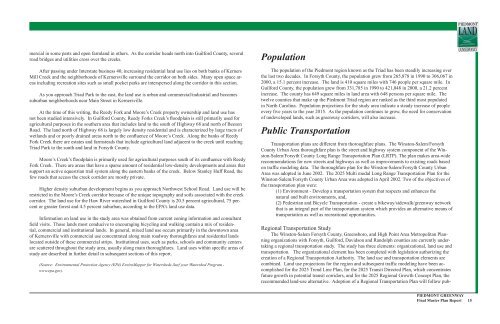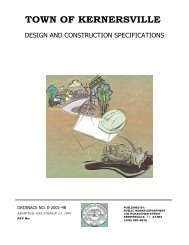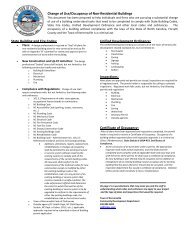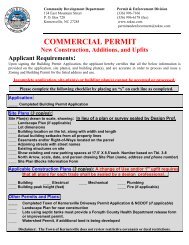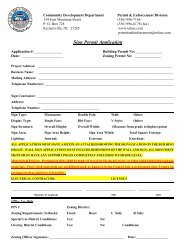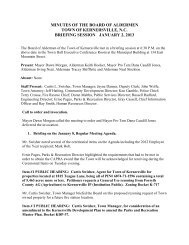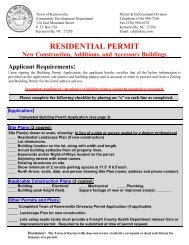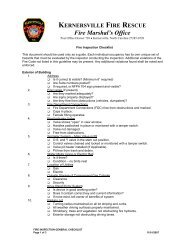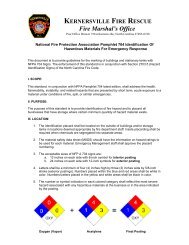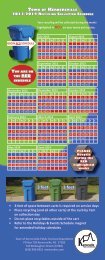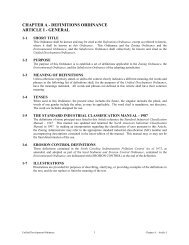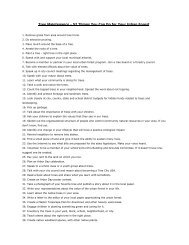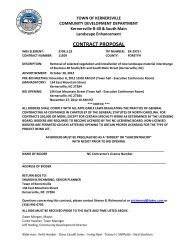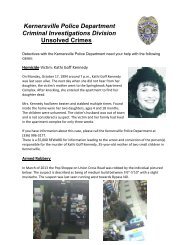Piedmont Greenway Master Plan - Town of Kernersville
Piedmont Greenway Master Plan - Town of Kernersville
Piedmont Greenway Master Plan - Town of Kernersville
- No tags were found...
Create successful ePaper yourself
Turn your PDF publications into a flip-book with our unique Google optimized e-Paper software.
mercial in some parts and open farmland in others. As the corridor heads north into Guilford County, several<br />
road bridges and utilities cross over the creeks.<br />
After passing under Interstate business 40, increasing residential land use lies on both banks <strong>of</strong> Kerners<br />
Mill Creek and the neighborhoods <strong>of</strong> <strong>Kernersville</strong> surround the corridor on both sides. Many open space areas<br />
including recreation sites such as small pocket parks are interspersed along the corridor in this section.<br />
As you approach Triad Park to the east, the land use is urban and commercial/industrial and becomes<br />
suburban neighborhoods near Main Street in <strong>Kernersville</strong>.<br />
At the time <strong>of</strong> this writing, the Reedy Fork and Moore’s Creek property ownership and land use has<br />
not been studied intensively. In Guilford County, Reedy Forks Creek’s floodplain is still primarily used for<br />
agricultural purposes in the southern area that includes land to the south <strong>of</strong> Highway 68 and north <strong>of</strong> Beeson<br />
Road. The land north <strong>of</strong> Highway 68 is largely low density residential and is characterized by large tracts <strong>of</strong><br />
wetlands and or poorly drained areas north to the confluence <strong>of</strong> Moore’s Creek. Along the banks <strong>of</strong> Reedy<br />
Fork Creek there are estates and farmsteads that include agricultural land adjacent to the creek until reaching<br />
Triad Park to the south and land in Forsyth County.<br />
Moore’s Creek’s floodplain is primarily used for agricultural purposes south <strong>of</strong> its confluence with Reedy<br />
Fork Creek. There are areas that have a sparse amount <strong>of</strong> residential low-density developments and areas that<br />
support an active equestrian trail system along the eastern banks <strong>of</strong> the creek. Below Stanley Huff Road, the<br />
few roads that access the creek corridor are mostly private.<br />
Higher density suburban development begins as you approach Northwest School Road. Land use will be<br />
restricted in the Moore’s Creek corridor because <strong>of</strong> the unique topography and soils associated with the creek<br />
corridor. The land use for the Haw River watershed in Guilford County is 20.5 percent agricultural, 75 percent<br />
or greater forest and 4.5 percent suburban, according to the EPA’s land use data.<br />
Information on land use in the study area was obtained from current zoning information and consultant<br />
field visits. Those lands most conducive to encouraging bicycling and walking contain a mix <strong>of</strong> residential,<br />
commercial and institutional lands. In general, mixed land use occurs primarily in the downtown area<br />
<strong>of</strong> <strong>Kernersville</strong> with commercial use concentrated along main roadway thoroughfares and residential lands<br />
located outside <strong>of</strong> these commercial strips. Institutional uses, such as parks, schools and community centers<br />
are scattered throughout the study area, usually along main thoroughfares. Land uses within specific areas <strong>of</strong><br />
study are described in further detail in subsequent sections <strong>of</strong> this report.<br />
(Source: Environmental Protection Agency (EPA) EnviroMapper for Watersheds-Surf your Watershed Program -<br />
www.epa.gov).<br />
Population<br />
The population <strong>of</strong> the <strong>Piedmont</strong> region known as the Triad has been steadily increasing over<br />
the last two decades. In Forsyth County, the population grew from 265,878 in 1990 to 306,067 in<br />
2000, a 15.1 percent increase. The land is 410 square miles with 746 people per square mile. In<br />
Guilford County, the population grew from 331,785 in 1990 to 421,048 in 2000, a 21.2 percent<br />
increase. The county has 649 square miles in land area with 648 persons per square mile. The<br />
twelve counties that make up the <strong>Piedmont</strong> Triad region are ranked as the third most populated<br />
in North Carolina. Population projections for the study area indicate a steady increase <strong>of</strong> people<br />
every five years to the year 2015. As the population continues to grow, the need for conservation<br />
<strong>of</strong> undeveloped lands, such as greenway corridors, will also increase.<br />
Public Transportation<br />
Transportation plans are different from thoroughfare plans. The Winston-Salem/Forsyth<br />
County Urban Area thoroughfare plan is the street and highway system component <strong>of</strong> the Winston-Salem/Forsyth<br />
County Long Range Transportation <strong>Plan</strong> (LRTP). The plan makes area-wide<br />
recommendations for new streets and highways as well as improvements to existing roads based<br />
on traffic modeling data. The thoroughfare plan for the Winston-Salem/Forsyth County Urban<br />
Area was adopted in June 2002. The 2025 Multi modal Long Range Transportation <strong>Plan</strong> for the<br />
Winston-Salem/Forsyth County Urban Area was adopted in April 2002. Two <strong>of</strong> the objectives <strong>of</strong><br />
the transportation plan were:<br />
(1) Environment - Develop a transportation system that respects and enhances the<br />
natural and built environments, and,<br />
(2) Pedestrian and Bicycle Transportation - create a bikeway/sidewalk/greenway network<br />
that is an integral part <strong>of</strong> the transportation system which provides an alternative means <strong>of</strong><br />
transportation as well as recreational opportunities.<br />
Regional Transportation Study<br />
The Winston-Salem Forsyth County, Greensboro, and High Point Area Metropolitan <strong>Plan</strong>ning<br />
organizations with Forsyth, Guilford, Davidson and Randolph counties are currently undertaking<br />
a regional transportation study. The study has three elements: organizational, land use and<br />
transportation. The organizational element has been completed with legislation authorizing the<br />
creation <strong>of</strong> a Regional Transportation Authority. The land use and transportation elements are<br />
combined. Land use projections for the region and subsequent traffic modeling have been accomplished<br />
for the 2025 Trend Line <strong>Plan</strong>, for the 2025 Transit Directed <strong>Plan</strong>, which concentrates<br />
future growth in potential transit corridors, and for the 2025 Regional Growth Concept <strong>Plan</strong>, the<br />
recommended land-use alternative. Adoption <strong>of</strong> a Regional Transportation <strong>Plan</strong> will follow pub-<br />
PIEDMONT GREENWAY<br />
Final <strong>Master</strong> <strong>Plan</strong> Report 15


